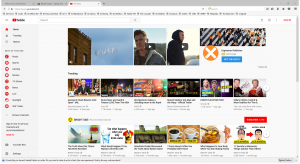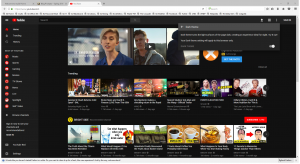
YouTube is the main way most people view online video. Given that, the design of the homepage does not do a good job of reflecting that. The biggest thing on the page is an advertisement for a channel on the site. It is centered at the top so it is the first thing a viewer sees. This shows that YouTube appeals a lot to advertisers.
Below it is a strip of trending videos. The algorithm for trending videos could be another blog post entirely. Below that is a recommended channel. Scrolling farther down one can see various more strips of videos from recommended channels or topics based on site history. These are the second biggest things on the screen aside from the advertisement, and are the next things to draw the viewer’s eye. Channel creators try to make eye-catching thumbnails so they stand out in this type of format. This format is intended to get the viewer to click on a video, which will preferably lead them to watch many more videos, increasing ad revenue. The large Subscribe button just above the recommended channel’s video bar encourages viewers to subscribe to the channel. The alignment of bars is reminiscent of streaming services like Netflix, and serves the purpose of showing multiple videos on one screen while signaling that they are all part of the same channel or category. There are also arrows that allow the viewer to scroll to see more options, showing that there are many videos to choose from.
The top bar is the logo, which links to the homepage, a search bar, and various tools for people who have YouTube accounts, including a Sign In button. The logo of the site itself is small, probably because it has reached such a level of recognition that it doesn’t feel the need to get the viewer to remember its name. The icons on the top and side are a fully saturated red that, frankly, is a little painful to look at against the white background. It does look marginally better in Dark Mode:

The icons along the side are bright red to draw the viewer’s attention, and they are the last thing that draw the viewer’s eye. Depending on the viewer’s interest, if they are idly browsing, they will click on one of the categories. Finally, there are the YouTube Red and Settings buttons. The color red has been an iconic part of YouTube’s design since its beginning. Red symbolizes energy, and when combined with the “You” in the title seems to convey the energy of the individual content creators and their communities.
The YouTube homepage, when one is not signed in is meant for idle browsers. It encourages users to watch as many videos as possible and sign up for an account so they can subscribe to the channels that interest them.
If one’s goal in visiting the site was to search for a specific video, the search bar is in a relatively convenient place though depending on a display’s settings it is small compared to the rest of the screen. The same is true if one’s goal is to sign in and view their more personalized homepage, which serves a similar function but with more customized video recommendations. The sidebar also shows playlists and subscriptions rather than broad categories.